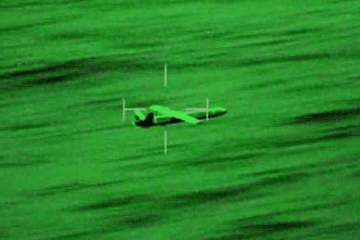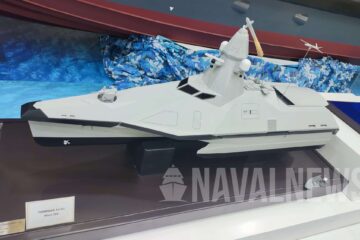Built by the Guizhou Aircraft Industry Corporation, outside analysis considered the original Air Force version of WZ-7’s role is similar to the US Air Force‘s Northrop Grumman RQ-4 Global Hawk, a long range drone capable of providing Intelligence, Surveillance and Reconnaissance (ISR) capability. On January 1st, the Japanese Ministry of Defense confirmed that a Chinese WZ-7 passed through the Miyako Strait and conducted operations beyond the first island chain. The Southwestern Air Defense Force of the Japan Air Self-Defense Force scrambled F-15Js to intercept and observe the drone as it entered the Japanese Air Defense Identification Zone. It was also the first time that the JASDF scrambled to respond to such high altitude aircraft.
The naval version of the WZ-7 is somewhat similar to the US Navy’s MQ-4C Triton, a naval variant of the RQ-4 with the focus of broad maritime surveillance in mind. From the images released, it appears that the naval version of WZ-7 has its nose, both wing roots and upper part of the forward fuselage fitted with Wave Transmitting Material. Since long range drones require beyond line of sight communication link, such as satellite communication to operate without the support of line of sight Ground Control Station, so it makes sense to have its upper part fitted with Wave Transmitting Material in order for the antenna to perform the satellite uplink and downlink function with the communication satellite up ahead. ESM antennas were embedded within the wing roots to intercept the communication or radar signatures from the surface combatants to perform direction-finding function in order to locate them passively. It might even have a certain degree of Signal Intelligence collection capability. However, the Wave Transmitting Material at the nose suggested that it is highly likely this variant houses a Look-Down radar at its nose.

For years, China has been trying establish its Anti-Access/Area Denial (A2/AD) capability to counter the US Carrier Strike Groups by introducing various Anti-Ship capability, including the DF-21D Anti-Ship Ballistic Missile which Chinese media often referred as the “Carrier Killer”. Like any other weapon, in order to hit its target, you first have to spot it in the first place. This variant of WZ-7 could use its radar and ESM suite to supplement the existing Chinese Maritime ISR network as an important part of the whole “Kill Chain” ecosystem with the focus of conducting long range ISR, relaying tactical maritime picture and building situation awareness to provide up to date targeting information for the anti-ship units.
Apart from radar, another possibility would be this variant of WZ-7 might not be a Triton-ish ISR drone after all. Since a modern Maritime Surveillance Aircraft typically has a 360 degree radar mounted in its belly radar fairing to create an unobstructed Look-Down line of sight towards the surface, most notably the MQ-4C Triton and MQ-9B Sea Guardian, it would be quite rare to see an aircraft with similar role to have a front-facing only radar instead of a Omni-directional one. In this case, the WZ-7 we are seeing might be a Stand-Off Jammer asset to degrade surface combatants’ communication or radar performance to disrupt and provide cover for the strike package.
WZ-7 HALE UAV main specifications

Length: 14.3m
Wingspan: 25m
Height: 5.4m
Takeoff Weight: 7,500kg (Around 16,500lb)
Mission Payload: 650kg (Around 1,400lb)
Cruising Altitude: Around 60,000 feet
Curising Speed: 750km/h (405 Knots)
Range: 7,000km (3,800 NM)






